 | ||
Brazil has a high level of urbanization: 82 out of every 100 Brazilians live in cities. The criteria used by the IBGE (Brazilian Institute of Geography and Statistics) in determining whether households are urban or rural, however, are based on political divisions, not on the built environment.
Nowadays, the country has more than 5,570 municipalities. About 87.86% of Brazilians live in urban areas.
The state capitals are also the largest cities in their respective states, exceptions being Florianópolis (which is the capital and the second largest city of Santa Catarina state after Joinville) and Vitória (which is the capital but only the fourth largest city of Espírito Santo state). There are also non-capital metropolitan areas in São Paulo (Campinas, Santos, Paraíba Valley), Minas Gerais (Vale do Aço), Bahia (Feira de Santana), Rio Grande do Sul (Sinos Valley), Santa Catarina (Joinville, Itajaí Valley), among others. Most of the non-capital large cities in Brazil are in the states of São Paulo (21), Rio de Janeiro (7), Minas Gerais (7), Pernambuco (5), Paraná (4), Rio Grande do Sul (3) and Espírito Santo (3).
Most populated cities in Brazil
This is a list of the most populous cities based on the population of the municipality where the city is located, rather than its metropolitan area. As IBGE considers the entire Federal District synonymous to Brasília, the population of the Federal District is shown for Brasília.
Brazil's population, as recorded by the 2010 Census, was of 190,755,799 inhabitants (22.40 inhabitants per square kilometer), with 84.36% of the population defined as urban. The population is heavily concentrated in the Southeast (80,4 million) and Northeast (53.1 million).
